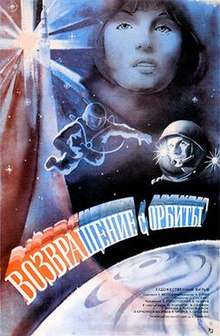Return from Orbit
| Return from Orbit | |
|---|---|
 | |
| Directed by | Aleksandr Surin |
| Written by | Evgeniy Mesyatsev |
| Starring | |
| Music by | Eduard Artemyev |
| Cinematography | Sergei Stasenko |
Production company | |
Release date |
|
Running time | 84 minutes |
| Country | Soviet Union |
| Language | Russian |
Return from Orbit (Russian: Возвращение с орбиты, translit. Vozvraschenie s orbiti) is a Soviet 1983 science fiction film directed by Aleksandr Surin.[1][2]
The film tells the story of how an accident occurs on an orbital space station due to meteoritic flow, as a result of which the ship's commander is seriously injured. He must be urgently delivered to Earth and testing must be continnued. It can only be done by the crew of Kuznetsov-Mukhin, who have been preparing for the flight for many years.
Plot
Pavel Kuznetsov and Vyacheslav Mukhin are not only good friends, but also are considered to be the most prepared crew in the cosmonaut detachment. They have been preparing for the first joint flight for many years, but at the start there was a crash of the carrier rocket, and the astronauts were saved by the alarm system.
Shortly before the new joint launch, Kuznetsov's wife suddenly dies, leaving him alone with his young daughter. Being in deep mourning, he not only refuses to fly into space, but decides to part with cosmonautics for good. Mukhin catches up with Kuznetsov's train, on which he is leaving Baikonur, but is not able to convince him to take the report. Going to the deserted station, he calls his friend Sasha in the middle of the night and offers her to marry him. The next day Mukhin is deployed with another partner.
Hearing on the radio the announcement of TASS about the launch, Kuznetsov's ally on the coupe characterizes the work of astronauts as an easy stroll for reward and fame, but Kuznetsov reminds him that there is a chance that they may not return.
During the flight at the orbital station there is an accident in the electrical circuit of the docking unit, as a result of which Mukhin's partner gets a serious wound and must be delivered quickly to Earth. However, as a result of the accident, their ship can not undock from the station. Kuznetsov, by order of the head of the cosmonaut detachment, Major-General Sviridov, is removed from the train, and he and his partner fly on the second ship to help Mukhin.
After dragging the wounded cosmonaut through the open space to Kuznetsov's ship which then returns to Earth, Mukhin and Kuznetsov restore the work of the station and leave it. However, their ship falls under a meteor shower, which breaks through the lining of the engine compartment and damages the shunting engines and the orientation system. Astronauts close their helmets and switch to a reserve oxygen supply which lasts for a maximum of 12 hours.
This time for help flies out Major-General Sviridov. Because of the air coming out of Kuznetsov's ship, it rotates strongly around its axis, which makes it almost impossible for Sviridov to dock with the ship. Taking advantage of Mukhin's idea, Kuznetsov leaves the ship in outer space and stops its rotation with a compressed gas cylinder and a spare engine of the orientation system.
Before the docking of the ships remains little time, Kuznetsov prepares to connect the air hose as soon as possible, but at this time his oxygen is running out. Mukhin switches the supply of oxygen from his spacesuit to his friend's, thereby condemning himself to death ...
Cast
- Juozas Budraitis - Colonel of Naval Aviation Pavel Kuznetsov
- Vitaly Solomin - engineer Vyacheslav Mukhin
- Aleksandr Porokhovshchikov - Major General of Aviation Alexei Evgenievich Sviridov
- Tamara Akulova - Sasha, Mukhin's friend
- Igor Vasiliev - head of the flight
- Lyubov Sergeyevna Sokolova - Sofia Petrovna, mother-in-law of Kuznetsov
- Igor Dmitriev - Kuznetsov's fellow traveler on the train
- Valery Yurchenko - Valery Romanov, partner of Mukhin
Production
Shooting in space was made on the Soviet space station Salyut 7 and the spacecraft Soyuz T-9 by cosmonauts Vladimir Lyakhov and Aleksandr Aleksandrov. Shooting was also conducted in the Yuri Gagarin Cosmonaut Training Center and in the RKA Mission Control Center.[3]
Awards
The film received a special prize and a diploma in 1984 at the 17th All-Union Film Festival (Kiev): in the program of feature films.[1]